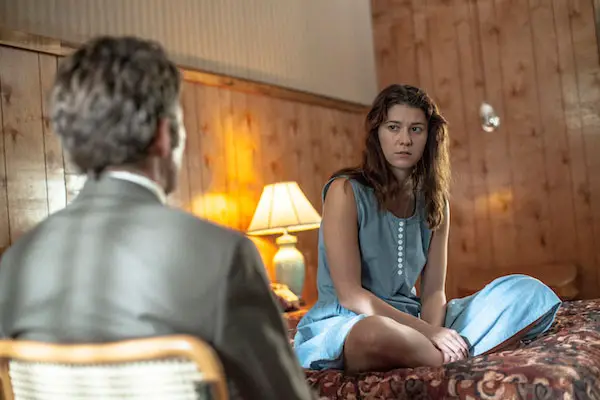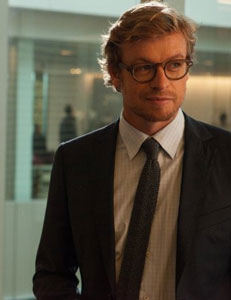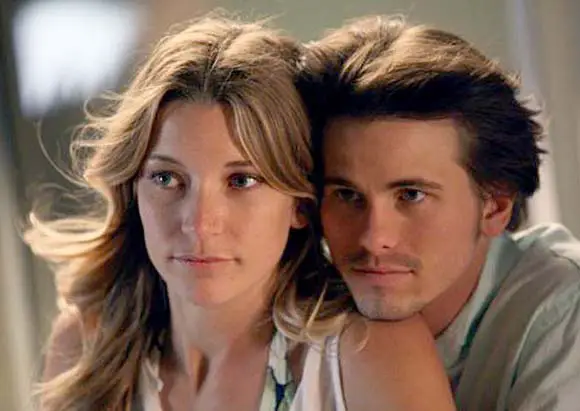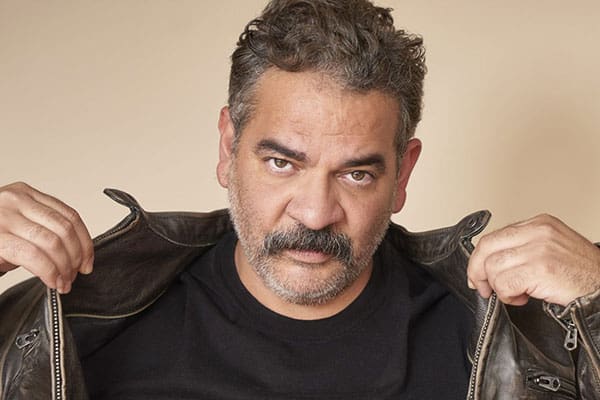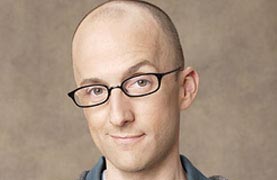Mary Elizabeth Winstead stars in Faults, director Riley Stearns feature directorial debut about a woman named Claire (Winstead) who is under the spell of a mysterious cult. When Claire’s parents recruit Ansel Roth (Leland Orser), a down-on-his-luck expert on cults and mind control, to help them deprogram her, the events of the next couple of days don’t go as he had planned.
The film, which Riley also wrote, is a great and interesting mash-up of black comedy, suspense and terror. You should definitely check it out because it’s well worth your time.
I talked to Mary at last year’s SXSW Festival (check out the interview here), and very cool to check back in with her. Especially since I hadnt had a chance to watch the film until last week.
Joining Mary on the interview was Riley, who happens to be her husband. In the interview, we talk about the film, shooting and acting in a confined space, not rehearsing a 12-page scene and the coolness of co-star Lance Reddick.
Check out Faults here or stream it on Amazon | Follow Mary and Riley on Twitter!
The film goes from a dark comedy to a thriller to this drama almost. Was it hard to find that balance when Riley you were shooting it and when you were acting it?
Riley Stearns: Well, for me because I wrote it wasn’t necessarily hard because I knew where I wanted to go and how I wanted to kind of twist the tone as it went along. And not necessarily switched up, but kind of not only shift into it. Like you said, it sneaks up on you and hopefully that’s what most people experience as they’re watching it.
But for me the key was knowing that even though it gets darker as it goes along, it never totally changes or loses its sense of humor. There’s the thing, and I won’t go into details, but you’ve seen it you’ll know what I’m talking about with the book. At the beginning of the movie he signs the book over to Claire’s parents, to Claire, and he hopes that she can find it useful in some way and then at the end of the movie he does something very horrific with that book. And for me, that was kind of funny that he would go… that that would come back in that way. And so keeping the humor throughout it but knowing that it didn’t totally go away was good for me to know and to kind of keep in mind.
What about you, Mary Elizabeth? Was it hard?
Mary Elizabeth Winstead: No, I think for me I just know Riley so well and I know his inspirations and his references and I know the point of reference for where he’s coming from on everything, so it felt like very natural the kind of shift and tone and the way the comedy kind of melded into the drama was very unique to Riley and something that I knew very well to kind of be his voice. So that I understood from the get go and I think that everybody he brought into the film kind of got that from the get go. And it just sort of inherently worked. I don’t think there was any big discussion, at least not that I recall, where Riley had to be like, “Ok guys, so the tone is gonna start shifting here and the humor is gonna kinda change,” everybody just kinda got it and it just felt very natural and very easy and we all just understood and went forth with that.
Now, when we last talked you said that your character was kind of like 3 different characters and now that I’ve seen it, yes. I totally understand what you were saying. So when you were shooting, was it difficult to sort of keep them straight? “Oh, who am I now?”
Mary Elizabeth Winstead: Right. We shot a lot chronologically, which was really helpful because we were shooting on the set for the most part inside the motel room. And so occasionally we’d go out, you know, all our exterior stuff was shot out of order and things like that. And sometimes we’d shoot a little bit out of order inside because we needed to get something done for some reason, but for the most part it was pretty chronological, which makes such a difference in knowing where you are in your headspace in any given moment. So that helped a lot, but it still was… I wanted them all to make sense within the same person. I didn’t want her to be like she has split personalities or anything like that. So it had to be subtle enough to not be too jarring but also different enough to make you wonder what’s going on with her. So it was a fine line.
I would imagine shooting chronologically, or almost chronologically, is one of the biggest luxuries ever.
Mary Elizabeth Winstead: It really is. I’ve had a couple of films now where I’ve been able to shoot close to chronological and it just feels as if you’re living as the character. You’re really just kind of in the story and letting it all unfold around you. It’s really wonderful. I love it.
Kind of at one point in the story there’s a shift for your character and I was like, “Wait, what? What just happened?” It’s one of those films I wanna go back and I wanna see if you left in clues. So, if I did go back to watch it, would I see those clues?
Mary Elizabeth Winstead: Well, I guess that’s up to the viewer. I certainly was playing all the scenes knowing where the movie ends up and having that in my mind in terms of the choices I was making, but they’re only as subtle or as overt as the eye of the beholder, I guess. So hopefully you’ll pick up on some of those things, but you never know what people will actually see or what is imperceptible.
Riley Stearns: I’ve seen the movie a million times and edited it and everything too, and I pick up on all of these little things that not only she’s doing but what Leland was doing and other actors in the film too. But, yeah, Mary’s got a lot of stuff that she does with her eyes where you can tell she’s like, “Did that work?” or, “Is he buying that?” or whatever it is. And, yeah, I see them clear as day, for sure.
Now I’ve gotta totally go back and watch it. A lot of the film takes place in one room, a hotel room. It didn’t feel like every shot was repeated, it all seemed kind of new and fresh.
Riley Stearns: I mean, that’s really cool you thought that because I didn’t want anything to feel stale or boring. I wanted to kind of mix up coverage a lot. A lot of the films I’m really inspired by, they don’t make safe choices and do an over the shoulder, over the shoulder. Or then you cut to the closeup. I wanted to challenge myself and the cinematographer and Mary and Leland even in the way that we were gonna shoot certain things.
I didn’t do any storyboarding, I think that’s one thing that helped for this movie at least was not going in with any preconceived notions of how I would shoot something. Or I guess a blueprint on how I was going to shoot something. I had an idea, I would make a shot list every weekend before shooting for that week and I would kind of follow that shot list. But then I would get to set and we would block it out and if something changed and I didn’t need that one shot anymore, I needed to add something else, I was prepared to do that. But it’s gonna sound dumb, but one thing that really helped in the blocking in the cinematography of the film was that I splurged and bought a really nice director’s viewfinder right before we shot and that was kind of the gift I gave myself to help me set up shop and things. And that never left my shoulder the entire time. I had that around my neck and I was using it on every shot and I had a rule, don’t take any photos of me using that because I’m gonna look like a dork. But it really became my best friend and I was able to pass it to the cinematographer and we used that as a really helpful tool to kind of see is that gonna work, is that shot gonna work, and before we had to get the camera in there and see that it didn’t work we kind of planned it out. So it’s just like planning ahead and doing little things like that, but I definitely didn’t want it to feel boring.
No, it didn’t at all. Yeah.
Riley Stearns: Good, good.
Mary, along the lines of that same question, you’re acting in this confined space for so long and you can’t, I would imagine, use any sort of actor-y tricks. Like there’s no walking and talking, you can’t grab a drink and make it… you know what I’m saying?
Mary Elizabeth Winstead: Yeah. Thankfully the script was so good and the words were so good and that’s, you know, always such a huge relief, as I’m sure you know, when you are saying the words and you’re not feeling like, “Oh God, how am I gonna make this work?” They’re coming out and they’re feeling good and they’re feeling interesting and it’s fun to play with and fun to experiment with. Just the words themselves and the emotions behind them.
And so I’m very lucky with that, that the script had enough layers to it that there was so much to play with there that I didn’t really need any external things to make it interesting. The characters themselves and the relationships and how they were relating to one another and manipulating one another and playing with one another mentally, all of that was so interesting to me as an actor and was a lot to sort of sink my teeth into, which made it so much easier.
There’s one scene, and when we last talked it was a 12 page scene, I think it was. And now that I’ve seen the movie, wow. And you said that, you and Leland said, that you guys didn’t want to rehearse. Riley, on your end, what were you thinking when they said, “No, we don’t wanna rehearse.”
Riley Stearns: The thing is at that point because we were shooting basically chronologically at that point, they’d already been the characters for at least a few weeks. And so I knew that they knew who they were and what they needed to do and I knew that Leland had been working with somebody outside of Mary and practicing lines and stuff, and just getting himself prepared and Mary had coached with her acting coach before we shot and I trusted them. If they said that they were prepared, I knew that they were pros and that they were prepared.
And so we got there that day and we went through it. And the reason that the non-rehearsal on those two worked so well is because the energy and the rawness of it kind of stayed with it.
We did everything in that 2 shot where they sit down and they kind of start that scene and she sits down and they start talking, they did that I want to say 5 times at the most and once we got the exact way that we saw that scene feeling and progressing, then we went back and we got Mary and Leland’s coverage on that. I think each time we did it twice, and so we didn’t do it enough times that it felt stagnant or that it ever felt like it lost any energy or sense of urgency.
So I think that the non-rehearsal aspect of it actually ended up making the scene work better than it might have had it been rehearsed. I think things might have felt more rehearsed, in a way, had we actually gone ahead and done it that way.
Mary, after you do a scene like that a couple of times are you just done for the day? Are you just spent?
Mary Elizabeth Winstead: Yeah, that was probably one of the more draining days, for Leland especially. An awesome thing about this role for me was I tended to feel pretty good at the end of the day every day and I kind of realized halfway through that I think part of that was because the character of Claire really was kind of in her element and enjoying the game she was playing. But that was kind of how I made sense of it. Because I was at a certain point I was like, “Why aren’t I more tired or more drained or more something? Why am I so just kind of like happy go lucky?” And then I kind of realized that I think it was because that was how Claire, that was how she truly felt underneath it all. Everything else was just an act. In reality she was enjoying everything that’s happening.
Is Lance Reddik as cool as I imagine him to be?
Riley Stearns: Lance Reddik is probably the coolest person alive.
Mary Elizabeth Winstead: Coolest.
Riley Stearns: And what’s funny is he’s so different from the characters that he plays, but he also plays so many different characters. I mean, in John Wick in a weird way that’s almost more like Lance Reddik. He’s like this cool just there to help kind of guy and he is also incredibly fit and he’s an appreciator of Shakespeare and can quote Macbeth out of nowhere, just pull out quotes. And he’s just one of those guys that you’re like, “How do you exist? How are you a real person?” I’m happy to say that he would not disappoint. He’s probably the coolest guy I’ve ever met.
And I’ve seen his work since… I think I saw him first in Oz and I don’t think he’s ever aged.
Riley Stearns: No, that’s the other thing. He’s like a young man. He’s incredibly fit, he always is a sharp dresser, he has really interesting ideas on clothes themselves too. I had the suggestion that he wear a bolo time for the film but he also took it to the next level by saying, “Well, maybe he should have a little bit of a Western theme as well.” And I totally works. I never would have thought of something like that would’ve worked, but he knows. He’s got really good intuition.

